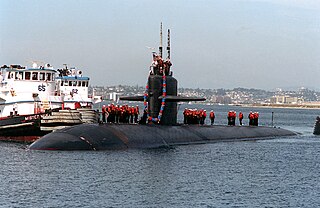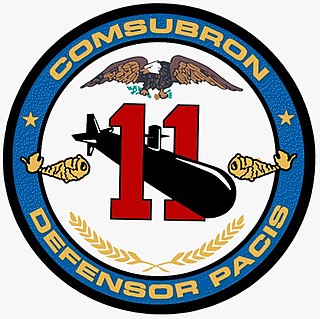
The Sturgeon class was a class of nuclear-powered fast attack submarines (SSN) in service with the United States Navy from the 1960s until 2004. They were the "workhorses" of the Navy's attack submarine fleet throughout much of the Cold War. The boats were phased out in the 1990s and early 21st century, as their successors, the Los Angeles, followed by the Seawolf and Virginia-class boats, entered service.

USS Glenard P. Lipscomb (SSN-685) was a unique nuclear-powered attack submarine of the United States Navy.

USS Seawolf (SSN-575) was the third ship of the United States Navy to be named for the seawolf, the second nuclear submarine, and the only US submarine built with a liquid metal cooled (sodium), beryllium-moderated nuclear reactor, the S2G. Her overall design was a variant of Nautilus, but with numerous detail changes, such as a conning tower, stepped sail, and the BQR-4 passive sonar mounted in the top portion of the bow instead of further below. This sonar arrangement resulted in an unusual bow shape above the water for a U.S. submarine. Her distinctive reactor was later replaced with a standard pressurized water reactor, the replacement process lasting from 12 December 1958 to 30 September 1960.

USS Essex (CV/CVA/CVS-9) was an aircraft carrier and the lead ship of the 24-ship Essex class built for the United States Navy during World War II. She was the fourth US Navy ship to bear the name. Commissioned in December 1942, Essex participated in several campaigns in the Pacific Theater of Operations, earning the Presidential Unit Citation and 13 battle stars. Decommissioned shortly after the end of the war, she was modernized and recommissioned in the early 1950s as an attack carrier (CVA), eventually becoming an antisubmarine aircraft carrier (CVS). In her second career, she served mainly in the Atlantic, playing a role in the Cuban Missile Crisis. She also participated in the Korean War, earning four battle stars and the Navy Unit Commendation. She was the primary recovery carrier for the Apollo 7 space mission.

USS Annapolis (SSN-760), is the tenth "improved" Los Angeles-class submarine. Annapolis is the fourth ship of the United States Navy to be named for Annapolis, Maryland, site of the United States Naval Academy.

USS Barb (SS-220), a Gato-class submarine, was the first ship of the United States Navy to be named for the Barbus, a genus of ray-finned fish. She compiled one of the most outstanding records of any U.S. submarine in World War II. During her seven war patrols, Barb is officially credited with sinking 17 enemy vessels totaling 96,628 tons, including the Japanese aircraft carrier Un'yō. In recognition of one outstanding patrol, Barb received the Presidential Unit Citation. On her twelfth and final patrol of the war, she landed a party of carefully selected crew members who blew up a train, the only ground combat operation in the Japanese home islands.

USS Omaha (SSN-692), a Los Angeles-class submarine, was the third ship of the United States Navy to be named for Omaha, Nebraska. The contract to build her was awarded to the Electric Boat Division of General Dynamics Corporation in Groton, Connecticut on 31 January 1971 and her keel was laid down on 27 January 1973. She was launched on 21 February 1976 sponsored by Mrs. Victoria Kuncl Hruska, wife of Senator Roman L. Hruska, and commissioned on 11 March 1978.

USS Jacob Jones was a Tucker-class destroyer built for the United States Navy prior to the American entry into World War I. The ship was the first U.S. Navy vessel named in honor of Jacob Jones.

USS Razorback (SS-394), a Balao-class submarine, was the only ship of the United States Navy to be named after the razorback, a species of whale found in the far southern reaches of the Pacific Ocean. She is arguably the longest-serving combat front-line submarine still existing in the world, having been commissioned by two different countries for 56 years of active duty. She was in Tokyo Bay during the surrender of Japan. In 2004, the state of Arkansas adopted the submarine and she is now a museum ship at the Arkansas Inland Maritime Museum.

USS Barb (SSN-596), a Permit-class attack submarine, was the second ship of the United States Navy to be named for the barb, a kingfish of the Atlantic coast.

USS San Francisco (SSN-711) is a Los Angeles-class nuclear submarine, the third ship or boat of the United States Navy to be named for San Francisco, California.

USS Pintado (SSN-672), a short hull Sturgeon-class attack submarine, was the second ship of the United States Navy to be named for the pintado, a large mackerel-like fish, whose elongated spots suggested the Spanish language word meaning "painted."

USS Tautog (SSN-639), a Sturgeon-class attack submarine, was the second ship of the United States Navy to be named for the Tautog, a wrasse commonly found along the Northern Atlantic coast. The submarine was in service from 17 August 1968 to 31 March 1997.

USS Pargo (SSN-650), a Sturgeon-class attack submarine, was the second ship of the United States Navy to be named for the pargo, also known as the red snapper, a fish of the genus Lutjanus found in the West Indies.

USS Buffalo (SSN-715) was a Los Angeles-class submarine, the second vessel that actively served the United States Navy to be named for Buffalo, New York. The contract to build her was awarded to Newport News Shipbuilding and Dry Dock Company in Newport News, Virginia on 23 February 1976, and her keel was laid down on 25 January 1980. She was launched on 8 May 1982 sponsored by Mrs. Joanne Kemp, wife of former Buffalo Bills quarterback and New York's 31st congressional district representative Jack Kemp, who was credited with winning approval to name the ship after the city in his district. Buffalo was commissioned on 5 November 1983, with Commander G. Michael Hewitt in command. Buffalo was decommissioned on 30 January 2019 after 35 years of service.

USS Chicago (SSN-721) is a Los Angeles-class submarine, the fourth ship of the United States Navy to be named for the city of Chicago, Illinois. The contract to build her was awarded to Newport News Shipbuilding and Dry Dock Company in Newport News, Virginia on 13 August 1981 and her keel was laid down on 5 January 1983. She was launched on 13 October 1984 sponsored by Mrs. Vicki Ann Paisley, wife of Melvyn R. Paisley assistant Secretary of the Navy, and commissioned on 27 September 1986.

USS Santa Fe (SSN-763), a Los Angeles-class submarine, is the second ship of the United States Navy to be named for Santa Fe, New Mexico. The contract to build her was awarded to the Electric Boat Division of General Dynamics Corporation in Groton, Connecticut on 21 March 1986 and her keel was laid down on 9 July 1991. She was launched on 12 December 1992 sponsored by Mrs. Joy Johnson, and commissioned on 8 January 1994, with Commander Rodger P. Krull in command.

Submarine Squadron 11 is a squadron of submarines based at Point Loma Submarine Base, San Diego, California, United States. Submarine Squadron 11 was commissioned July 1, 1986, aboard her flagship, McKee, at Naval Submarine Base Point Loma, San Diego. Their missions include anti-submarine, anti-surface, strike, special and mine warfare, intelligence, surveillance and reconnaissance. The squadron currently consists of four Los Angeles-class submarines for deployments to the Western Pacific, Indian Ocean and the Persian Gulf.

Helicopter Sea Combat Squadron 14 (HSC-14) "Chargers" is an aviation unit of the United States Navy based at Naval Air Station North Island, California (USA). HSC-14 was established as Helicopter Anti-Submarine Squadron 14 (HS-14) in 1984 and was redesignated HSC-14 in 2013. The squadron is equipped with the Sikorsky MH-60S Seahawk.



















